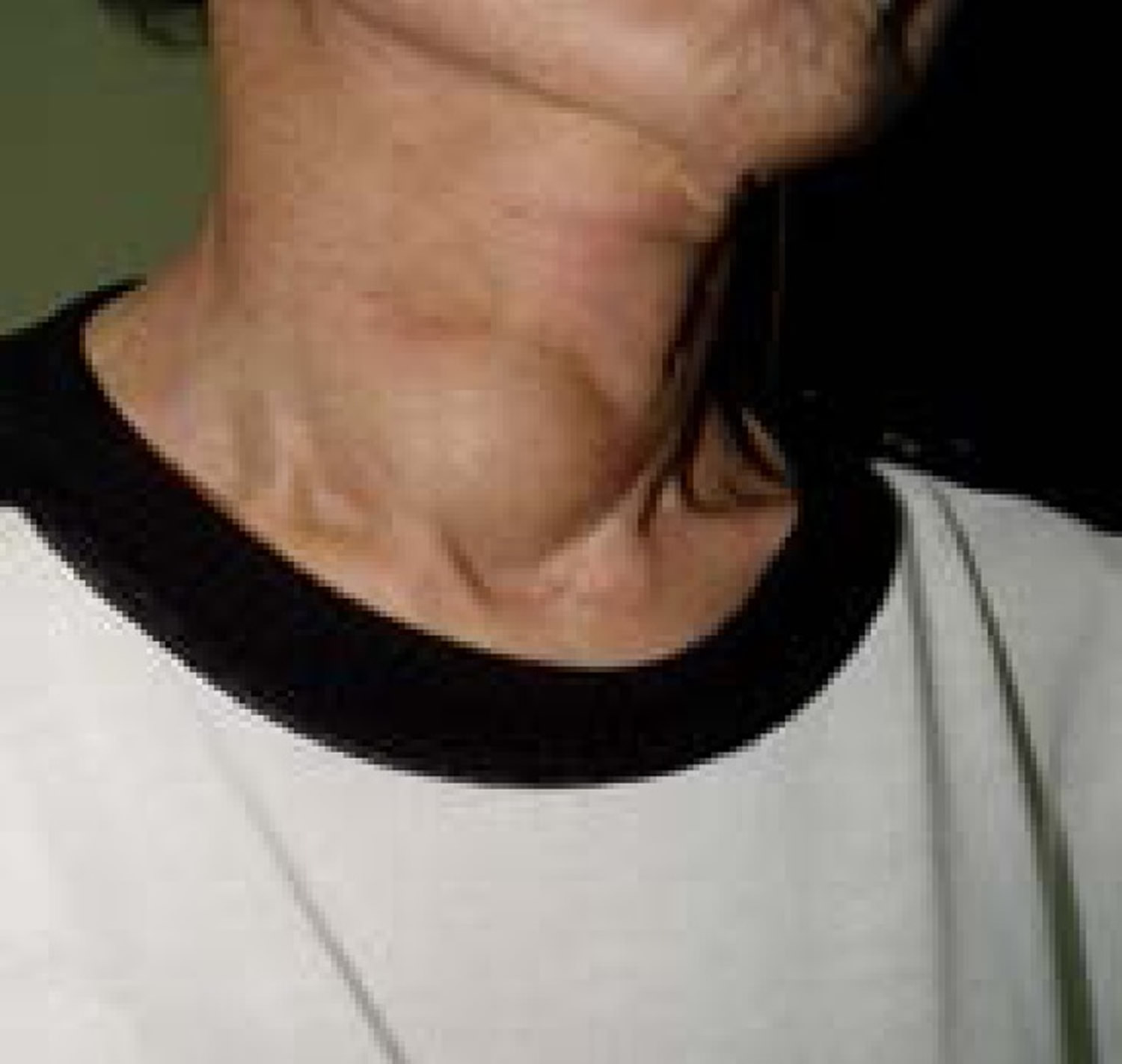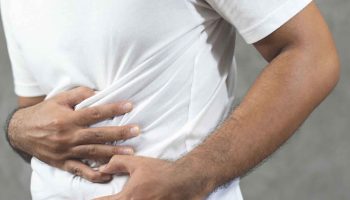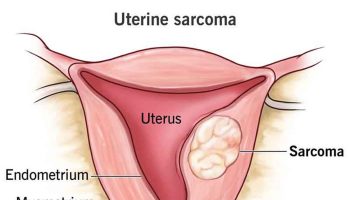Riedel thyroiditis
Riedel thyroiditis or Riedel’s thyroiditis, is a rare, chronic inflammatory and infiltrative disease of the thyroid gland that is characterized by a dense fibrosis that replaces normal thyroid parenchyma 1. The fibrotic process invades adjacent structures of the neck and extends beyond the thyroid capsule. This feature differentiates Riedel thyroiditis from other inflammatory or fibrotic disorders of the thyroid. Extension beyond the thyroid also differentiates this from the fibosing variant of Hashimoto thyroiditis. Riedel thyroiditis is characterized by breathing difficulties and dysphagia resulting from pressure from a rapidly enlarging thyroid. In rare cases, it can cause voice hoarseness if the enlarged thyroid damages the recurrent laryngeal nerve.
Riedel thyroiditis can also be associated with systemic fibrotic processes, Hashimoto thyroiditis and Graves disease 2. Systemic multifocal fibrosclerosis is a syndrome characterized by fibrosis involving various organs, including those of the retroperitoneum and mediastinum, the orbit, lung, bile duct, lacrimal gland, and parotid gland. In several studies, Riedel thyroiditis was regarded as one clinical symptom of multifocal fibrosclerosis 3. Particularly, Fatourechi et al. 4 reported that 38% of patients with Riedel thyroiditis showed a fibrotic process that extended beyond the neck. Recent studies have claimed that Riedel thyroiditis is more likely associated with multifocal fibrosclerosis and immunoglobulin G4-related systemic disease (IgG4-RSD). IgG4-RSD is a disease in which a mass may be formed by inflammatory activation of IgG4-positive plasma cells that are related to fibrosclerosis and obliterative phlebitis 5. Riedel thyroiditis is considered a type of multifocal fibrosclerosis seen in IgG4-RSD due to its immunohistochemical profile 6.
Heufelder and Hay 7 reported the incidence of Riedel thyroiditis in patients with Graves disease, and McIver et al. 8 discussed Graves disease in patients with unilateral Riedel thyroiditis. In the latter study, Graves disease occurred within 3 years after Riedel thyroiditis stabilization, indicating the important role of an autoimmune mechanism in causing Riedel thyroiditis. This case study also suggests the involvement of an autoimmune mechanism in Riedel thyroiditis because the patient had medical history of hyperthyroidism over the last three decades and Graves disease on admission.
Most Riedel thyroiditis cases have good outcome. Mortality rarely occurs as a result of complications such as pneumonia and breathing difficulties caused by the pressure of the enlarged mass on the trachea.
Small-scale studies and case reports have been conducted to address the effects of drug treatment on Riedel thyroiditis, reporting good outcomes with the use of corticosteroids 9. This medicine proved to be effective as early treatment in life-threatening extending fibrosis. Treatment with corticosteroids often takes a long-term course as symptoms often get worse after the drug is stopped. The antiestrogen tamoxifen is also effective in restraining the expansion of connective tissue. A study achieved good outcomes after using tamoxifen in a patient with progressive Riedel thyroiditis, although the patient took corticosteroids after surgery 10. The mechanism of tamoxifen is unknown, but it appears to be related to transforming growth factor-β stimulation, which suppresses immature fibroblast and epithelial cells.
A surgical treatment is required when tissue sample is necessary for diagnosis, drug therapy fails, and pressure symptom is severe. A wedge resection in isthmic portion of the thyroid enables the surgeon to obtain tissue while separating the left and right lobes and easing pressure. Since the dissection of a mass is not easy due to adhesion to surrounding tissue, any extensive surgery such as subtotal or total thyroidectomy is not recommended.
Riedel thyroiditis causes
The cause of Riedel thyroiditis is not yet clear, but an immune disorder is considered the most likely cause 11. Recent research has shown that immunoglobulin G4-related systemic disease (IgG4-RSD) is likely involved 5.
One theory of pathogenesis postulates that Riedel thyroiditis results from an autoimmune process. A second theory holds Riedel thyroiditis to be a primary fibrotic disorder. However, immunoglobulin G4-related systemic disease (IgG4-RSD) may unify these 2 seemingly disparate etiologies.
Autoimmune theory
The following evidence supports an autoimmune pathogenesis for Riedel thyroiditis:
- The presence of antithyroid antibodies in a significant percentage of patients with Riedel thyroiditis (67% of 178 cases reviewed in one study) 12
- The pathologic features of cellular infiltration, including lymphocytes, plasma cells, and histiocytes
- The frequent presence of focal vasculitis on pathologic examination
- The favorable response of a subset of patients with Riedel thyroiditis to treatment with systemic corticosteroids
However, the presence of normal lymphocyte subpopulations and normal serum complement levels weighs against an autoimmune mechanism. Elevated levels of antithyroid antibodies may merely reflect the immune system’s exposure to sequestered antigens released by the destruction of thyroid parenchyma from a primary fibrotic disorder.
Primary fibrotic disorder theory
The theory that Riedel thyroiditis is a primary fibrotic disorder is supported by its association with multifocal fibrosclerosis. This uncommon idiopathic syndrome is characterized by fibrosis involving multiple organ systems. The extracervical manifestations of multifocal fibrosclerosis can include retroperitoneal fibrosis, mediastinal fibrosis, orbital pseudotumor, pulmonary fibrosis, sclerosing cholangitis, lacrimal gland fibrosis, and fibrous parotitis. Riedel thyroiditis may be but 1 manifestation of this multifocal disease.
The histopathologic changes of Riedel thyroiditis closely resemble those observed in multifocal fibrosclerosis. Additionally, one third of published Riedel thyroiditis cases have demonstrated at least 1 manifestation of extracervical fibrosclerosis. The ability of systemic corticosteroids and tamoxifen to inhibit fibrogenesis accounts for the favorable effect of such treatment in both conditions 13.
Immunoglobulin G4-related systemic disease (IgG4-RSD) disorder
Immunoglobulin G4-related systemic disease (IgG4-RSD) is a relatively new group of disorders that share similar presentations. These disorders have in common a preponderance of excess IgG4. The disorders are characterized by lymphoplasmacytic infiltrates containing IgG4-positive plasma cells 14. These infiltrates ultimately lead to fibrosis and elevated serum levels of IgG4 15.
Riedel thyroiditis symptoms
Riedel thyroiditis is characterized by the replacement of normal thyroid parenchyma with dense fibrotic tissue and by the extension of this fibrosis to adjacent structures of the neck. Most patients are euthyroid (normal thyroid function), but hypothyroidism (underactive thyroid) is noted in approximately 30% of cases. Rarely, hyperthyroidism (overactive thyroid) can occur, but this is probably secondary to a coexisting condition.
Most patients with Riedel thyroiditis are admitted to the hospital because of a rapidly enlarging goiter and its pressure on surrounding tissue. Thyroid nodules extend to both lobes in most cases, are solid like a stone, and are fixed as a result of invasion and adhesion to surrounding tissue. The pressure that the enlarged thyroid puts on surrounding structures causes shortness of breath, dysphagia, suffocation, and hoarseness. Clinical features of Riedel thyroiditis closely resemble those of thyroid cancer, thyroid lymphoma, and Hashimoto thyroiditis. Patients note a nonpainful, rapidly growing thyroid mass. However, fibrotic proliferation to surrounding tissue is not common in these diseases.
Patients typically present with a hard, fixed, painless goiter. The character of the thyroid gland is often described as stony or woody. The onset of the goiter may be sudden, but it is usually gradual.
Local compressive symptoms are frequent and can include the following:
- Neck tightness or pressure
- Shortness of breath (dyspnea)
- Difficulty swallowing (dysphagia)
- Hoarseness
- Choking
- Cough
Such symptoms are the result of the increasing thyroid mass or are due to the extension of the fibrotic process to adjacent neck structures (eg, strap muscles, trachea, esophagus, recurrent laryngeal nerve).
Hypoparathyroidism is rare and presumably reflects fibrotic involvement of the parathyroid glands. Recurrent laryngeal nerve paralysis is also uncommon, but it can be observed in extensive disease 16.
Approximately one third of patients with Riedel thyroiditis have an associated extracervical manifestation of multifocal fibrosclerosis. These manifestations can include the following 17:
- Retroperitoneal fibrosis
- Mediastinal fibrosis
- Orbital pseudotumor
- Pulmonary fibrosis
- Sclerosing cholangitis
- Lacrimal gland fibrosis
- Fibrosing parotitis
Riedel thyroiditis diagnosis
Lab results in Riedel thyroiditis are usually nonspecific; most patients with these diseases maintain normal thyroid function. According to Cleveland Clinic’s report, 64% of total patients had normal thyroid function, 32% had hypothyroidism, and 4% had hyperthyroidism 18. Nearly 45% to 67% of patients were positive for antithyroid antibody, but the titer of antibody was lower than that in patients with Hashimoto thyroiditis.
It is important to differentiate characteristics of Riedel thyroiditis from those of Hashimoto thyroiditis. Along with fibrosis of thyroid tissue, fibrosis of surrounding structures and obstructive phlebitis differentiates Riedel thyroiditis from characteristics of Hashimoto thyroiditis. In terms of immunohistochemical profile, overall fibrosis and infiltration with granulocytes, monocytes, and eosinophils are more severe in Riedel thyroiditis, while fibrosis with histiocytes and CD8+ T&B lymphocytes is less severe compared to Hashimoto 19. Harach and Williams 20 presented differences between Riedel thyroiditis and Hashimoto’s using immunohistochemical staining. According to their study results, Riedel thyroiditis contained a greater number of λ-IgA in histiocytes, while Hashimoto showed a greater number of κ-IgG 20. Although differences between Riedel thyroiditis and Hashimoto are identifiable through clinical, histological, and immunological tests, caution is needed to obtain the proper diagnosis.
Riedel thyroiditis is a very rare disease, and its clinical characteristics are not easily differentiated from those of thyroid carcinoma, primary thyroid lymphoma, and undifferentiated carcinoma. One distinguishing feature of Riedel thyroiditis is the absence of associated cervical adenopathy. The final diagnosis therefore depends on histological findings. As Harigopal et al. 21 suggested, Riedel thyroiditis can be diagnosed based on triplicated findings of fine needle aspiration biopsy (FNAB) performed with an adequate amount of specimen, physical examination, antibody test, and radiological test. However, obtaining adequate amount of specimen necessary for testing is not easy in fine needle aspiration biopsy (FNAB) and core needle biopsy. Also, suspicious cells may be found in collected tissues. Accurate diagnosis of Riedel thyroiditis requires open biopsy 22. Therefore, surgical biopsy is usually performed instead of these methods. In this study, thyroid cancer was suspected based on radiological imaging, while FNA revealed only adenomatous goiter. A thyroidectomy was performed for histological diagnosis and treatment. In thyroidectomy, the dissection process is often very difficult as the fibrotic mass can extend to the bronchus, cervical muscle, esophagus, and nerve plexus. The thyroid frequently is hard like cartilage and does not have blood vessels, so it often does not bleed during dissection. In this study, the dissection was difficult as the mass was adhered to the airway and recurrent laryngeal nerve.
Imaging studies may suggest a diagnosis of Riedel thyroiditis, but findings can be nonspecific. Although image scans show decreased thyroid uptake and an inhomogeneous pattern in Riedel thyroiditis, other kinds of thyroiditis can also present this way. Riedel thyroiditis is seen on ultrasound as an irregular and hypoechoic lesion due to extensive fibrosis. A CT scan is the best test to confirm the invasion of the mass to surrounding organs. In CT imaging, a lesion appears hypodense, but the lesion’s density is reinforced after the administration of contrast agent. A lesion appears low signal intensity in T1 and T2-weighted magnetic resonance imaging 23.
The laboratory findings in Riedel thyroiditis are also nonspecific. The erythrocyte sedimentation rate (ESR) is generally elevated. Most patients remain euthyroid, but approximately 30% of patients become hypothyroid. Rarely, patients are hyperthyroid 12.
Although clinical features of Riedel thyroiditis closely resemble those of anaplastic carcinoma of the thyroid, Riedel thyroiditis and anaplastic carcinoma can be distinguished from each other by immunohistochemistry.
In one review, antithyroid antibody levels (TG-Ab and TPO-Ab) were found to be elevated in 67% of 178 cases of Riedel thyroiditis 12. However, it is not certain whether such autoantibodies are pathogenic or whether their presence merely reflects exposure of the immune system to sequestered antigens released by the fibrotic destruction of normal thyroid parenchyma 24.
IgG4 levels can be measured in the serum and are elevated in over 95% of cases. The levels can be as high as 25 times the upper limit of normal 25. However, levels can occasionally be normal, and evaluating IgG4/IgG ratios or immunohistochemical examinations can be helpful. As noted previously, Riedel’s thyroiditis is characterized by lymphoplasmacytic infiltrates containing IgG4-positive plasma cells.
Riedel’s thyroiditis treatment
The rarity of Riedel’s thyroiditis makes controlled studies of Riedel thyroiditis therapy impractical. Recommendations for medical treatment have been largely based on empirical experience. Pharmacologic therapy includes the use of corticosteroids and tamoxifen. Small-scale studies and case reports have been conducted to address the effects of drug treatment on Riedel thyroiditis, reporting good outcomes with the use of corticosteroids 26. This medicine proved to be effective as early treatment in life-threatening extending fibrosis. Treatment with corticosteroids often takes a long-term course as symptoms often get worse after the drug is stopped. The antiestrogen tamoxifen is also effective in restraining the expansion of connective tissue. A study achieved good outcomes after using tamoxifen in a patient with progressive Riedel thyroiditis, although the patient took corticosteroids after surgery 10. The mechanism of tamoxifen is unknown, but it appears to be related to transforming growth factor-β stimulation, which suppresses immature fibroblast and epithelial cells. For patients resistant to these therapies, there are less well validated studies, which have included mycophenolate mofetil 27 and rituximab 28. Levothyroxine can be used to treat the approximately 30% of patients who develop hypothyroidism. Calcitriol can be used for the rare complication of hypoparathyroidism.
Surgery for patients with Riedel thyroiditis serves the dual purpose of establishing the diagnosis and relieving tracheal compression. A wedge resection of the thyroid isthmus remains the preferred method for accomplishing these ends. Surgery is indicated when tissue is needed for diagnosis, medical treatment shows no benefit, or compressive symptoms are very severe 29.
Riedel thyroiditis prognosis
Riedel thyroiditis is generally a self-limited disease with a favorable prognosis. Death due to airway compromise is very rare in treated patients. Occasionally, spontaneous remission has been reported. Patients can also relapse.
In Riedel thyroiditis, morbidity is most frequently related to local compressive symptoms, such as dysphagia, dyspnea, hoarseness, and cough. Hypothyroidism is present in 30% of cases. Fibrotic invasion of adjacent anatomic structures may infrequently result in symptoms related to recurrent laryngeal nerve paralysis or hypoparathyroidism.
One third of patients with Riedel thyroiditis ultimately develop at least 1 extracervical manifestation of multifocal fibrosclerosis (such as retroperitoneal fibrosis, mediastinal fibrosis, or sclerosing cholangitis) 30. In such patients, the prognosis essentially becomes that of extracervical fibrosclerosis. Therefore, when Riedel thyroiditis is diagnosed, it is essential to perform abdominal and chest imaging studies to exclude concomitant, extracervical entities from multifocal fibrosclerosis. Fibrosclerosis of the surrounding tissue by Riedel thyroiditis can lead to serious morbidity and death.
A retrospective institutional review of a rare form of invasive thyroiditis from the Mayo Clinic discussed the common presenting symptoms and extrathyroidal involvement of the systemic fibrosclerosis. Treatments used in the 21 reported patients included partial thyroidectomy, tamoxifen, and corticosteroid therapy. Other, less well validated studies include mycophenolate mofetil 27 and rituximab 28. Of note, no cause-specific mortality was noted, and the fibrotic process stabilized or partially resolved in all patients 13.
- Riedel thyroiditis. https://emedicine.medscape.com/article/125243-overview[↩]
- Lee DY, Moon JS, Kim GE, Kim HK, Kang HC. Riedel thyroiditis in a patient with graves disease. Endocrinol Metab (Seoul). 2013;28(2):138–143. doi:10.3803/EnM.2013.28.2.138 https://www.ncbi.nlm.nih.gov/pmc/articles/PMC3811709[↩]
- Papi G, LiVolsi VA. Current concepts on Riedel thyroiditis. Am J Clin Pathol. 2004;121(Suppl):S50–S63.[↩]
- Fatourechi MM, Hay ID, McIver B, Sebo TJ, Fatourechi V. Invasive fibrous thyroiditis (Riedel thyroiditis): the Mayo Clinic experience, 1976-2008. Thyroid. 2011;21:765–772[↩]
- Divatia M, Kim SA, Ro JY. IgG4-related sclerosing disease, an emerging entity: a review of a multi-system disease. Yonsei Med J. 2012;53:15–34[↩][↩]
- Dahlgren M, Khosroshahi A, Nielsen GP, Deshpande V, Stone JH. Riedel’s thyroiditis and multifocal fibrosclerosis are part of the IgG4-related systemic disease spectrum. Arthritis Care Res (Hoboken) 2010;62:1312–1318[↩]
- Heufelder AE, Hay ID. Evidence for autoimmune mechanisms in the evolution of invasive fibrous thyroiditis (Riedel’s struma) Clin Investig. 1994;72:788–793.[↩]
- McIver B, Fatourechi MM, Hay ID, Fatourechi V. Graves disease after unilateral Riedel’s thyroiditis. J Clin Endocrinol Metab. 2010;95:2525–2526.[↩]
- Yasmeen T, Khan S, Patel SG, Reeves WA, Gonsch FA, de Bustros A, Kaplan EL. Clinical case seminar: Riedel’s thyroiditis: report of a case complicated by spontaneous hypoparathyroidism, recurrent laryngeal nerve injury, and Horner’s syndrome. J Clin Endocrinol Metab. 2002;87:3543–3547[↩]
- Jung YJ, Schaub CR, Rhodes R, Rich FA, Muehlenbein SJ. A case of Riedel’s thyroiditis treated with tamoxifen: another successful outcome. Endocr Pract. 2004;10:483–486.[↩][↩]
- Wan SK, Chan JK, Tang SK. Paucicellular variant of anaplastic thyroid carcinoma. A mimic of Reidel’s thyroiditis. Am J Clin Pathol. 1996;105:388–393.[↩]
- Schwaegerle SM, Bauer TW, Esselstyn CB Jr. Riedel’s thyroiditis. Am J Clin Pathol. 1988 Dec. 90(6):715-22.[↩][↩][↩]
- Fatourechi MM, Hay ID, McIver B, Sebo TJ, Fatourechi V. Invasive fibrous thyroiditis (riedel thyroiditis): the mayo clinic experience, 1976-2008. Thyroid. 2011 Jul. 21(7):765-72.[↩][↩]
- Pusztaszeri M, Triponez F, Pache JC, Bongiovanni M. Riedel’s thyroiditis with increased IgG4 plasma cells: evidence for an underlying IgG4-related sclerosing disease?. Thyroid. 2012 Sep. 22(9):964-8.[↩]
- Divatia M, Kim SA, Ro JY. IgG4-related sclerosing disease, an emerging entity: a review of a multi-system disease. Yonsei Med J. 2012 Jan. 53(1):15-34.[↩]
- Hennessey JV. Clinical review: Riedel’s thyroiditis: a clinical review. J Clin Endocrinol Metab. 2011 Oct. 96(10):3031-41[↩]
- Oguz KK, Kiratli H, Oguz O, et al. Multifocal fibrosclerosis: a new case report and review of the literature. Eur Radiol. 2002 May. 12(5):1134-8[↩]
- Schwaegerle SM, Bauer TW, Esselstyn CB., Jr Riedel’s thyroiditis. Am J Clin Pathol. 1988;90:715–722.[↩]
- Papi G, Corrado S, Carapezzi C, De Gaetani C, Carani C. Riedel’s thyroiditis and fibrous variant of Hashimoto’s thyroiditis: a clinicopathological and immunohistochemical study. J Endocrinol Invest. 2003;26:444–449.[↩]
- Harach HR, Williams ED. Fibrous thyroiditis: an immunopathological study. Histopathology. 1983;7:739–751[↩][↩]
- Harigopal M, Sahoo S, Recant WM, DeMay RM. Fine-needle aspiration of Riedel’s disease: report of a case and review of the literature. Diagn Cytopathol. 2004;30:193–197.[↩]
- Perimenis P, Marcelli S, Leteurtre E, et al. [Riedel’s thyroiditis: current aspects]. Presse Med. 2008 Jun. 37(6 Pt 2):1015-21.[↩]
- Perez Fontan FJ, Cordido Carballido F, Pombo Felipe F, Mosquera Oses J, Villalba Martin C. Riedel thyroiditis: US, CT, and MR evaluation. J Comput Assist Tomogr. 1993;17:324–325.[↩]
- Li Y, Nishihara E, Kakudo K. Hashimoto’s thyroiditis: old concepts and new insights. Curr Opin Rheumatol. 2011 Jan. 23(1):102-7.[↩]
- Khosroshahi A, Stone JR, Pratt DS, Deshpande V, Stone JH. Painless jaundice with serial multi-organ dysfunction. Lancet. 2009 Apr 25. 373(9673):1494.[↩]
- Yasmeen T, Khan S, Patel SG, Reeves WA, Gonsch FA, de Bustros A, Kaplan EL. Clinical case seminar: Riedel’s thyroiditis: report of a case complicated by spontaneous hypoparathyroidism, recurrent laryngeal nerve injury, and Horner’s syndrome. J Clin Endocrinol Metab. 2002;87:3543–3547.[↩]
- Levy JM, Hasney CP, Friedlander PL, Kandil E, Occhipinti EA, Kahn MJ. Combined mycophenolate mofetil and prednisone therapy in tamoxifen- and prednisone-resistant Reidel’s thyroiditis. Thyroid. 2010 Jan. 20(1):105-7.[↩][↩]
- Soh SB, Pham A, O’Hehir RE, Cherk M, Topliss DJ. Novel use of rituximab in a case of Riedel’s thyroiditis refractory to glucocorticoids and tamoxifen. J Clin Endocrinol Metab. 2013 Sep. 98(9):3543-9.[↩][↩]
- Lorenz K, Gimm O, Holzhausen HJ, et al. Riedel’s thyroiditis: impact and strategy of a challenging surgery. Langenbecks Arch Surg. 2007 Jul. 392(4):405-12.[↩]
- Oguz KK, Kiratli H, Oguz O, et al. Multifocal fibrosclerosis: a new case report and review of the literature. Eur Radiol. 2002 May. 12(5):1134-8.[↩]





